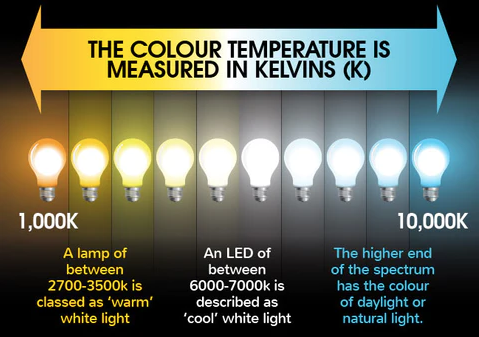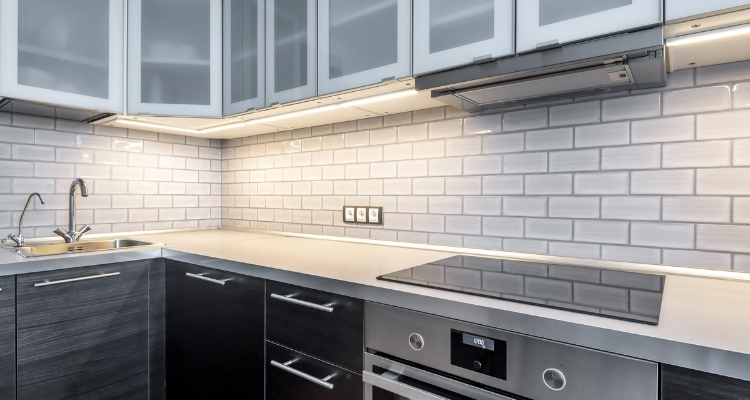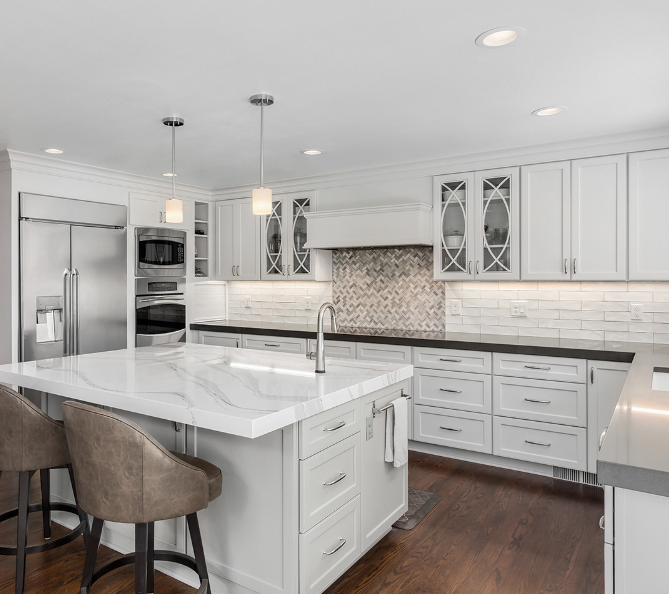Navigating the world of lighting can be daunting, especially when faced with decisions like choosing between 3000K and 4000K. This guide aims to help unravel these complexities and make it easier for you to create the perfect ambiance and functionality for your space. But first, let’s understand what Kelvins are and how they relate to lighting.

Kelvins in Lighting: A Brief Introduction
In the world of lighting, Kelvins (K) refers to the color temperature of a light source. It’s not about heat, but rather, it describes how the light appears to the human eye. The Kelvin scale ranges from 1000K, which produces a warm, almost red light, up to 10000K, which outputs a blue, almost icy light.
Here’s a guide to the spectrum of available CCTs:
- 2700K: Warm White – Creates a warm, cozy atmosphere.
- 3000K: Soft White – Provides a balanced, inviting light. Often used in residential spaces.
- 3500K: Neutral White – Often used in commercial or professional environments.
- 4000K: Cool White – Used in areas where you need clarity, such as kitchens or bathrooms.
- 5000K: Bright White – Often used in workspaces or for reading.
- 6500K: Daylight – Typically used in commercial spaces or task-oriented spaces.
Within the realm of residential lighting, the most commonly used options are typically the 3000K and 4000K LED bulbs. As a result, many homeowners find themselves deliberating between these two CCTs due to their wide applicability and distinct lighting atmospheres.


3000K Color Temperature
A 3000K light is classified as Warm White, creating a welcoming, cozy atmosphere with a slight yellowish hue. It’s perfect for living rooms, bedrooms, and dining areas, where you want to foster a relaxed and comfortable environment.

Is 3000K LED Lights Warm or Cool?
LED lights with a 3000K color temperature produce a light that’s noticeably warmer and more yellow compared to bulbs with higher color temperatures, giving off a glow similar to traditional incandescent bulbs. This characteristic often makes them a favored choice for those seeking to evoke a classic or nostalgic ambiance in their space.
Nonetheless, it’s worth noting that a 2700K LED or equivalent bulb emits an even more pronounced yellow hue. This effect can be particularly distinct when using energy-efficient COB LED downlights. Despite the inviting warmth of these lights, their strong yellow undertone can make them less ideal for task-oriented lighting situations where a more neutral or cool light might be preferred.
4000K Color Temperature
4000K lighting, often referred to as Neutral White, gives off a whiter and brighter light that is more similar to natural daylight. It’s often described as crisp and invigorating. This lighting is suitable for spaces where you need clarity and precision, such as kitchens, bathrooms, and workspaces.

Is The Light from 4000K LEDs Too Bright?
Concerning the brightness of 4000K LED lights, they strike a balance between the warm and cool ends of the spectrum, offering a neutral and versatile light that’s suitable for a variety of spaces. Contrary to some beliefs, 4000K LED lights are not overly bright.
The neutral white light they produce is clear and vibrant, making them an excellent choice for areas like living rooms, bathrooms, and kitchens where clarity and a stylish aesthetic is desired. Furthermore, with the availability of dimmable LEDs, you can adjust the brightness according to your personal preferences and the specific needs of your space.
It’s worth noting that the brightness perception may vary among individuals, and it’s always best to consider the particular usage and personal comfort when selecting light color temperatures.
3000K vs 4000K: Unveiling the Differences
Choosing between the two really depends on the desired mood and functionality of the space. For areas where you want to unwind and relax, a warmer color temperature like 3000K would be appropriate. In contrast, areas where tasks are performed, like the kitchen or home office, might benefit from a cooler color temperature such as 4000K.
Keep in mind that this is not a one-size-fits-all situation. Personal preference also plays a huge part in this decision. Some people might prefer warmer lighting throughout their homes for a cozy feel, while others may prefer cooler lighting for its crisp and clean aesthetic.
Another factor to consider is the color scheme and decor of your space. For instance, cooler lighting might complement a modern or minimalist interior, whereas warmer lighting might enhance the rustic or traditional decor.
In terms of brightness, a higher color temperature doesn’t necessarily mean a brighter light. The perceived brightness is affected by the light’s lumens, not it’s color temperature. However, cooler light can often appear brighter to the human eye due to its color.
Here’s a comparison chart to help you understand the differences between 3000K, 4000K, and 5000K LED lights:
| Color Temperature | Appearance | Feeling Produced | Common Applications |
|---|---|---|---|
| 3000K LEDs | Warm, Yellowish Light | Cozy, Relaxing | Residential Spaces, Living Rooms, Bedrooms |
| 4000K LEDs | Neutral, Bright White Light | Alertness, Focus | Commercial Spaces, Offices, Retail Stores |
| 5000K LEDs | Vibrant, Daylight-like Light | Energizing, High Visibility | Large Commercial Spaces, Outdoor Areas, Workshops |
So, in the debate between 3000K vs 4000K LED bulbs, the decision is truly personal and depends on the type of atmosphere you want to create in your space.

Scientific and Psychological Aspects of Light
Finally, keep in mind that science and psychology also influence our perception of light. The light spectrum of 3000K and 4000K varies, with 3000K emitting more red and yellow light, and 4000K emitting more blue light. This influences how we perceive the colors of objects under the light.
Psychologically, different color temperatures can have different effects on mood and behavior. Warm white lighting, for example, helps regulate melatonin production, a hormone that controls your sleep cycles. This can create a relaxed feeling and set the mood for a good night’s sleep. Conversely, cooler light (like 4000K) is associated with alertness and productivity. It can trigger serotonin production, a hormone associated with wakefulness and alertness. That’s why 4000K light could be beneficial in spaces like home offices or kitchens, where you’d want to feel more energetic and focused.

How Do I Decide Between 3000K and 4000K LED Lights?
When deciding between 3000K vs. 4000K LED lights, it’s crucial to factor in your personal preferences, the style of your home, and the specific lighting needs of your space. LEDs are known for their energy efficiency, emitting ample light while using less electricity.
However, the choice between 3000K and 4000K involves more than energy savings. The light temperature can impact our bodily responses – warm white lighting, for instance, may foster relaxation and enhance sleep quality, while bright lights may stimulate alertness.
Consider Dimming Options
If you wish to recreate the dynamic light pattern of the sun, considering dimmable LEDs could be advantageous. This feature allows your light fixtures to emit either warm, cool, or bright white light, offering you the flexibility to adapt the ambience of a room to your liking.
Think about the Utility
The utility of your lighting choice shouldn’t be overlooked. Different spaces may have different lighting requirements. For instance, the warm light of 3000K LEDs can instantly set a calming mood in living rooms, while the crisp, bright light from 4000K LEDs can enhance clarity and focus, making it an excellent choice for kitchens, garages, or bathrooms.
Health Implications
Another key aspect to consider when choosing between 3000K and 4000K LED lights is the potential health implications. Exposure to excessively bright light, for example, can cause eye strain over time. This is why many prefer the gentler light of 3000K LEDs for bedrooms.
Applications
To further guide your decision, here are some typical residential and commercial applications for different color temperatures:
- Task Lighting: For activities requiring high focus and clarity, such as reading or cooking, 4000K LED lighting is preferred.
- Utility Work: For garage work and home maintenance, the bright light of 4000K LEDs is beneficial.
- Ambient Lighting: The color temperature for ambient lighting can vary, with the main aim being to match the mood and aesthetic of the room.
- Bedside Lamps: For relaxing activities such as bedtime reading, the warmer 3000K LEDs can be a better choice.
- Outdoor Lighting: For security purposes, 4000K LEDs or higher, emitting more blue light, can be more effective.
- Accent Lighting: To highlight artwork or architectural details, 4000K accent lights can provide the necessary focus.
In conclusion, your choice between 3000K and 4000K LED lights largely depends on your specific needs and preferences. Balancing these factors will help you make an informed decision for optimal lighting in your home or workspace.
Is 3000K or 4000K Better for a Kitchen?
The choice between 3000K and 4000K LED lights for a kitchen depends on the desired ambiance and the kitchen’s specific lighting needs.
4000K lights, with their neutral white light, are often a popular choice for kitchens. This is because they offer a balanced, bright illumination that aids in tasks requiring attention to detail, such as chopping, cooking, and cleaning.
However, some may prefer 3000K lights in the kitchen for their warmer and cozier feel. This could be particularly suitable if your kitchen doubles as a dining or socializing space, where a more relaxing ambiance might be desired.
Additionally, you might consider using a combination of both. For instance, you could use 4000K lights over work areas for task lighting, and 3000K lights in dining or seating areas for more ambient, comfortable illumination.
It’s also worth considering that many modern LED lights are dimmable or offer variable color temperatures, providing even more flexibility to adjust the lighting to your needs and preferences at different times of the day or for different uses of the space.
In the end, the “better” choice is highly subjective and should be based on your personal preferences and how you use your kitchen.
Buy LED Lights from Sinolumi LED Ltd
Understanding the different color temperatures is a crucial first step in choosing the right lighting for your space. However, to truly create the perfect atmosphere, it’s essential to pair this knowledge with quality products from a reliable manufacturer.
This is where Sinolumi LED Ltd comes into play. As one of the leading LED light manufacturers, Sinolumi offers a vast array of lighting solutions, including downlights, track lights, and spotlights, to cater to your unique needs and preferences.
Operating from China, Sinolumi prides itself on prioritizing the needs and requirements of its customers. We strive to provide not just top-notch LED products in a range of color temperatures, but also insightful advice to guide you in making the best lighting decisions for your space.
Whether you have a specific LED light requirement or need help figuring out what would work best for your home or office, don’t hesitate to reach out. Send us your query, and let us guide you towards the ideal lighting solution that best matches your considerations.
FAQs
Conclusion
The choice between 3000K and 4000K lighting fundamentally comes down to the mood you want to create and the purpose of the room. While both offer their own unique benefits, it’s important to consider your personal preference and the functionality of the space when making your decision. Remember, lighting is an influential element of your environment, so choose wisely.
